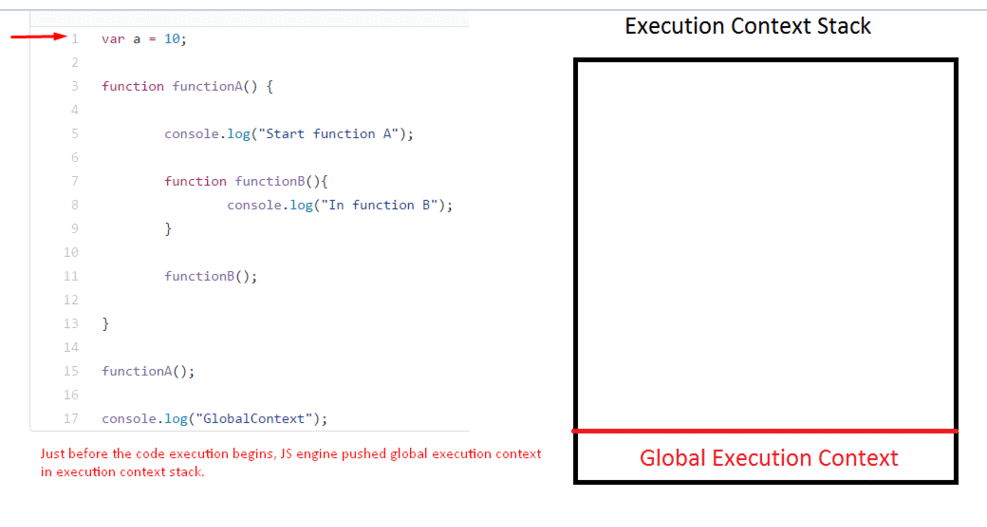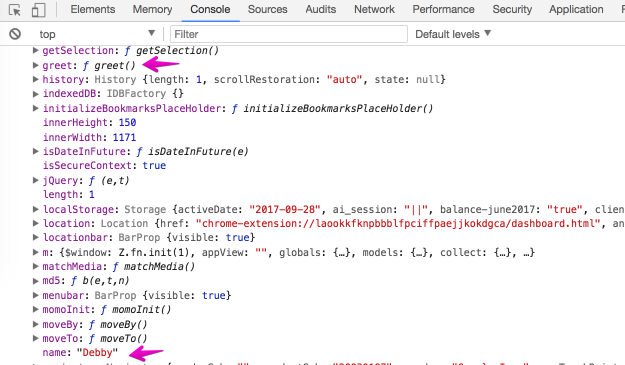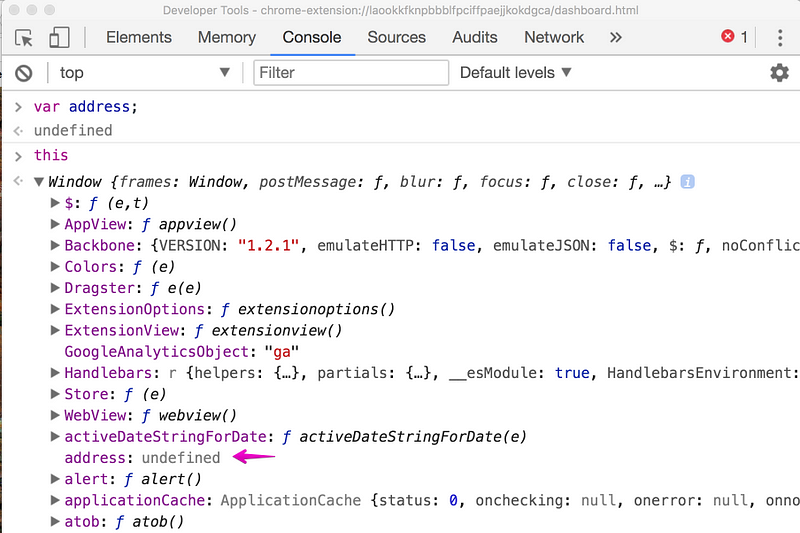Understanding the JavaScript Engine—— two phase
Understanding the JavaScript Engine — Part 1

I have been a Ruby on Rails developer for the last 2 years. I have used JavaScript both in its vanilla form and in some frameworks. However, I learned JavaScript as most new programmers do, by going through a course, without quite understanding how the JavaScript engine works.
Before diving deep into JavaScript, I decided to take some time off and understand its core working principles. I’ll be sharing what I’ve learned so far in this, and subsequent blog posts.
First, let me define some terms you’ll come across. I’ll add examples where necessary.
Syntax Parser
When you write code, a compiler converts your code into a set of instructions that the computer can understand. Part of the compiler is what is known as a syntax parser. The syntax parser goes through your code character by character, and determines if the syntax is valid or not.
Lexical Environment
In simple terms, a Lexical environment refers to where something sits physically in your code. Where something is written gives an idea of how the computer will interpret it and how it will interact with other variables and functions e.g
function hello() {
var greet = "Hello world"
}
In the function above, we can say that var greet sits lexically in the function.
Execution Context
This is a wrapper that helps manage the code that is running. Looking at the gif below, you can see there’s an execution context stack and in it, we have a Global execution context. When functionA() is called, it is added to the Stack meaning that functionA() is currently being executed. The same goes for functionB().

The execution context is created in two phases:
The first phase is called the creation phase. The global execution context creates two things for you, that you don’t have in your code; a global object(window) and a special variable called this. The window object is a global object inside a browser. This object is different depending on whether you are using node or running JavaScript on the server. But there is always a global object when you’re running JavaScript. Take a look at the following image from a browser console:

When you create a variable and function that is not inside a function, those variables and functions get attached to the global object.
var name = "Debby";
function greet() {
console.log("Hello", name)
}
If you run the above JavaScript code in the browser and you inspect the global object, you will see that the variable and the function were added to it.

During the creation phase, the syntax parser recognizes where you have defined variables and functions. It therefore sets up memory space for the variables and functions. It’s not actually moving code to the top of the page. What this means is that before your code begins to be executed line by line, the JavaScript engine has already set aside memory space for the variables and functions that you’ve written. This is what is called Hoisting.
The next phase is the execution phase, where assignments are made. When the JavaScript engine sets up memory space for variables, it doesn’t know which values will be stored in them. Therefore, it puts a placeholder called undefined. That placeholder means; I don’t know what this value is yet. All variables in JavaScript are initially set to undefined while functions sit in memory in their entirety. This is why it’s possible to declare a variable without assigning it and the JavaScript engine will not throw any error.

This is just a brief introduction to how the JavaScript engine executes the code you write. To know more, you can use the resources below:
JavaScript: Understanding the Weird Parts by Anthony Alicea on Udemy.Execution context, Scope chain and JavaScript internals by Rupesh Mishra.
Understanding the JavaScript Engine—— two phase的更多相关文章
- 「2014-3-13」Javascript Engine, Java VM, Python interpreter, PyPy – a glance
提要: url anchor (ajax) => javascript engine (1~4 articles) => java VM vs. python interpreter =& ...
- Javascript Engine, Java VM, Python interpreter, PyPy – a glance
提要: url anchor (ajax) => javascript engine (1~4 articles) => java VM vs. python interpreter =& ...
- Browser Render Engine & Javascript Engine
Browser Render Engine Programming Language Open Source Javascript Engine Comparation for CSS Compati ...
- JavaScript Engine 可视化
JavaScript Engine 可视化 图解 JavaScript Engine JavaScript 可视化 (7 部曲) ️ JavaScript Visualized: Event Loop
- Understanding Delegated JavaScript Events
While I ended up using a CSS-only implementation for this pen, I started by writing it mostly using ...
- v8 javascript engine
https://code.google.com/p/v8-wiki/wiki/BuildingWithGYP vs2013git v8 http://github.com/v8/v8-git-mirr ...
- Attacking JavaScript Engines: A case study of JavaScriptCore and CVE-2016-4622(转)
转:http://phrack.org/papers/attacking_javascript_engines.html Title : Attacking JavaScript Engines: A ...
- Bring JavaScript to your Java enterprise with Vert.x
转自:https://opensource.com/article/18/4/benefits-javascript-vertx If you are a Java programmer, chanc ...
- JavaScript Interview Questions: Event Delegation and This
David Posin helps you land that next programming position by understanding important JavaScript fund ...
随机推荐
- thinkphp5.0生命周期
本篇内容我们对ThinkPHP5.0的应用请求的生命周期做大致的介绍,以便于开发者了解整个执行流程. 1.入口文件 用户发起的请求都会经过应用的入口文件,通常是 public/index.php文件. ...
- EAP-MD5认证暴力破解工具eapmd5pass
EAP-MD5认证暴力破解工具eapmd5pass EAP-MD5是一种基于802.1x协议的认证机制.由于该机制存在漏洞,所以并不能保证数据安全.Kali Linux预置一个专用工具eapmd5 ...
- 【BZOJ 2711】 2711: [Violet 2]After 17 (0-1 背包)
2711: [Violet 2]After 17 Time Limit: 5 Sec Memory Limit: 128 MBSubmit: 224 Solved: 153 Description ...
- android studio 继续汉化 编译项目 菜单
韩梦飞沙 韩亚飞 313134555@qq.com yue31313 han_meng_fei_sha Edit Flavors...
- [APIO2014]序列分割 --- 斜率优化DP
[APIO2014]序列分割 题目大意: 你正在玩一个关于长度为\(n\)的非负整数序列的游戏.这个游戏中你需要把序列分成\(k+1\)个非空的块.为了得到\(k+1\)块,你需要重复下面的操作\(k ...
- 【最小割】【Dinic】HihoCoder - 1252 - The 2015 ACM-ICPC Asia Beijing Regional Contest - D - Kejin Game
题意:有一个技能学习表,是一个DAG,要想正常学习到技能x,要将指向x的技能全部先学到,然后会有一个正常花费cx.然后你还有一种方案,通过氪金dx直接获得技能x.你还可以通过一定的代价,切断一条边.问 ...
- 【最小表示法】BZOJ2882-工艺
[题目大意] 求一个循环数列的最小表示法. [思路] 最小表示法模板题.之前用SAM做的,MLE了hhhhh戳☆ #include<iostream> #include<cstdio ...
- python开发_random
和java中的random()函数一样,在python中也有类似的模块random,即随机数 下面是我做的demo 运行效果: ==================================== ...
- iOS Masonry的使用需要注意的地方
自动布局最重要的是约束:UI元素间关系的数学表达式.约束包括尺寸.由优先级和阈值管理的相对位置.它们是添加剂,可能导致约束冲突 .约束不足造成布局无法确定 .这两种情况都会产生异常. 使用前:Auto ...
- iOS可持续化集成: Jenkins + bundler + cocoapods + shenzhen + fastlane + pgyer
工具介绍 1. bundler bundler用于管理ruby gem的工具,我们用来管理cocoapods以及fastlane的版本.直接sudo gem install bundler就可以.然后 ...
